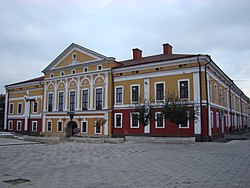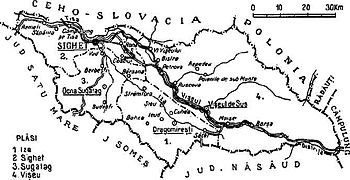| Revision as of 23:18, 21 June 2018 editRosenborg BK Fan (talk | contribs)Extended confirmed users29,701 edits →Demographics: Updated section← Previous edit | Revision as of 19:41, 25 June 2018 edit undoRosenborg BK Fan (talk | contribs)Extended confirmed users29,701 editsm →Demographics: Minor updateNext edit → | ||
| Line 37: | Line 37: | ||
| == Demographics == | == Demographics == | ||
| ] ({{lang-de|Frauenbach}}), the largest municipality and the county seat.]] | ] ({{lang-de|Frauenbach}}), the largest municipality and the county seat.]] | ||
| In 2011, the county had a population of 461,290 and a ] of {{convert|73.17|PD/km2}}. | In 2011, the county had a population of 461,290 and a ] of {{convert|73.17|PD/km2}}. | ||
Revision as of 19:41, 25 June 2018
Template:Infobox County Romania
Maramureș (Template:IPA-ro) is a county (județ) of Romania, in the Maramureș region. The county seat is Baia Mare.

Name
In Hungarian, it is known as Máramaros megye, in Ukrainian as Мараморо́щина, and in German as Kreis Marmarosch.
History
Maramureș County as an administrative division within Romania was formed following the union of Transylvania with Romania. During World War II, it was ceded to Hungary, and after the war returned to Romania (see History of Maramureș).
- The 10th century frontier county of Borsova was founded by Stephen I of Hungary. Since then Máramaros served as the north-eastern border of the Hungarian Kingdom until 1920, the Trianon Peace Treaty.
- 11th century historical Maramureș counties separation from Borsova (Rom. Borșa)
- 1241 Tartar invasion decimated about half of the local population
- 14th century Duke (knyaz) Bogdan of Maramureș said to be founder of Moldova
- In the Middle Ages, the historical region of Maramureș was known for its salt mines and later for its lumber
- In 1920 after the Treaty of Trianon, the northern part of the county became part of newly formed Czechoslovakia. The southern part (including Sighetu Marmației) became part of Romania.
- For more information regarding the history see Máramaros, referring the historical Hungarian name of the county.
Demographics

In 2011, the county had a population of 461,290 and a population density of 73.17 inhabitants per square kilometre (189.5/sq mi).
- Romanians - 82.38% (or 380,018)
- Hungarians - 7.53% (or 34,781)
- Ukrainians - 6.77% (or 31,234)
- Romani - 2.73% (or 12,638)
- Germans (Zipser Germans) - 0.27% (or 1,243), and others.
In 1910, 18.4% of the county were Jewish.
| Year | County population |
|---|---|
| 1948 | 321,287 |
| 1956 | |
| 1966 | |
| 1977 | |
| 1992 | |
| 2002 | |
| 2011 |
Geography
Maramureș County is situated in the northern part of Romania, and has a border with Ukraine. This county has a total area of 6,304 square kilometres (2,434 sq mi), of which 43% is covered by the Rodna Mountains, with its tallest peak, Pietrosul, at 2,303 metres (7,556 ft) altitude. Together with Gutâi and Țibleș mountain ranges, the Rodna mountains are part of the Eastern Carpathians. The rest of the county are hills, plateaus, and valleys. The county is crossed by Tisa River and its main tributaries: Iza, Vișeu, and Mara rivers.
Neighbours
 AB
AR
AG
BC
BH
BN
BT
BV
BR
BZ
CS
CL
CJ
CT
CV
DB
DJ
GL
GR
GJ
HR
HD
IL
IS
IF
MM
MH
MS
NT
OT
PH
SM
SJ
SB
SV
TR
TM
TL
VS
VL
VN
B
AB
AR
AG
BC
BH
BN
BT
BV
BR
BZ
CS
CL
CJ
CT
CV
DB
DJ
GL
GR
GJ
HR
HD
IL
IS
IF
MM
MH
MS
NT
OT
PH
SM
SJ
SB
SV
TR
TM
TL
VS
VL
VN
B
- Suceava County to the East.
- Satu Mare County to the West.
- Ukraine to the North - Ivano-Frankivsk Oblast and Zakarpattia Oblast.
- Sălaj County, Cluj County and Bistrița-Năsăud County to the South.
Economy
Maramureș is known for its pastoral and agricultural traditions, largely unscathed by the industrialisation campaign that had been carried on during Romania's communist period. Ploughing, planting, harvesting, and hay making and handling are mostly done through manual labour. The county is also home to a strong mining industry of extraction of metals other than iron. The industrial plants built around Baia Mare during the communist period heavily polluted the area in the past, but recently, due to the decline of the city's industrial activity, the area is less polluted.
Tourism

The region is known for its beautiful rural scenery, local small woodwork and craftwork industry as well as for its churches and original rural architecture. There are not many paved roads in rural areas, and most of them are usually accessible.
The county's main tourist attractions:
- The cities of Baia Mare and Sighetu Marmației.
- The villages on the Iza, Mara, and Vișeu Valleys.
- The Rodna Mountains.
- The landscape of Cavnic.
Politics
The Maramureș County Council, elected at the 2016 local government elections, is made up of 35 counselors, with the following party composition:
Administrative divisions




Maramureș County has 2 municipalities, 11 towns and 63 communes.
- Municipalities
- Baia Mare - county seat; population: 114,925 (as of 2011)
- Sighetu Marmației
- Towns
- Communes
- Ardusat
- Ariniș
- Asuaju de Sus
- Băița de sub Codru
- Băiuț
- Bârsana
- Băsești
- Bicaz
- Bistra
- Bocicoiu Mare
- Bogdan Vodă
- Boiu Mare
- Botiza
- Breb
- Budești
- Călinești
- Câmpulung la Tisa
- Cernești
- Cicârlău
- Coaș
- Coltău
- Copalnic-Mănăștur
- Coroieni
- Cupșeni
- Desești
- Dumbrăvița
- Fărcașa
- Gârdani
- Giulești
- Groși
- Groșii Țibleșului
- Ieud
- Lăpuș
- Leordina
- Mireșu Mare
- Moisei
- Oarța de Jos
- Ocna Șugatag
- Onceşti
- Petrova
- Poienile de sub Munte
- Poienile Izei
- Recea
- Remetea Chioarului
- Remeți
- Repedea
- Rona de Jos
- Rona de Sus
- Rozavlea
- Ruscova
- Săcălășeni
- Săcel
- Sălsig
- Săpânța
- Sarasău
- Satulung
- Șieu
- Șișești
- Strâmtura
- Suciu de Sus
- Vadu Izei
- Valea Chioarului
- Vima Mică
- Vișeu de Jos
Historical county
County in Romania| Județul Maramureș | |
|---|---|
| County (Județ) | |
 The Maramureş County Prefect's building from the interwar period. The Maramureş County Prefect's building from the interwar period. | |
 Coat of arms Coat of arms | |
 | |
| Country | |
| Historic region | Maramureș |
| Capital city (Reședință de județ) | Sighet |
| Area | |
| • Total | 3,381 km (1,305 sq mi) |
| Population | |
| • Total | 194,619 |
| Time zone | UTC+2 (EET) |
| • Summer (DST) | UTC+3 (EEST) |
Administration
In 1930, the county was originally divided into three districts (plăṣi):
- Plasa Iza
- Plasa Sighet (headquartered at Sighet)
- Plasa Vișeu (headquarted at Vișeu de Sus)
Subsequently the Iza and Sighet districts were reorganized into three districts, adding one:
- Plasa Şugatag (headquarted at Ocna Şugatag)
Population
According to the 1930 census, the county's population was 194,619, 57.9% Romanian, 20.9% Jews, 11.9% Ruthenians (including Ukrainians), 6.9% Hungarians, 2.0% Germans, as well as other minorities. The following composition was recorded from the religious point of view: 64.4% Greek Catholic, 21.0% Jewish, 6.4% Roman Catholic, 5.3% Eastern Orthodox, 1.8% Reformed, as well as other minorities.
Urban population
In 1930, the county's urban population ethnically consisted of 38.6% Jews, 35.4% Romanians, 19.9% Hungarians, 4.5% Ruthenians (including Ukrainians), as well as other minorities. Yiddish was spoken by 36.6% of the urban population, followed by Romanian (33.7%), Hungarian (25.7%), Ukrainian (2.3%), as well as other minorities. From the religious point of view, the urban inhabitants were Jewish (38.9%), Greek Catholics (38.0%), Roman Catholics (12.8%), Reformed (5.7%), Eastern Orthodox (3.5%), as well as other minorities.

People
Natives of the county include:
References
- National Institute of Statistics, "Populația după etnie" Archived 2009-08-16 at the Wayback Machine
- National Institute of Statistics, "Populația la recensămintele din anii 1948, 1956, 1966, 1977, 1992 și 2002" Archived 2006-09-22 at the Wayback Machine
- "Mandate de CJ pe judete si competitori" (in Romanian). Biroul Electoral Central. 10 June 2016. Retrieved 16 June 2016.
- Portretul României Interbelice - Județul Maramureș
- ^ Recensământul general al populației României din 29 decemvrie 1930, Vol. II, pag. 276-277
47°40′22″N 24°00′18″E / 47.67278°N 24.00500°E / 47.67278; 24.00500
Categories: